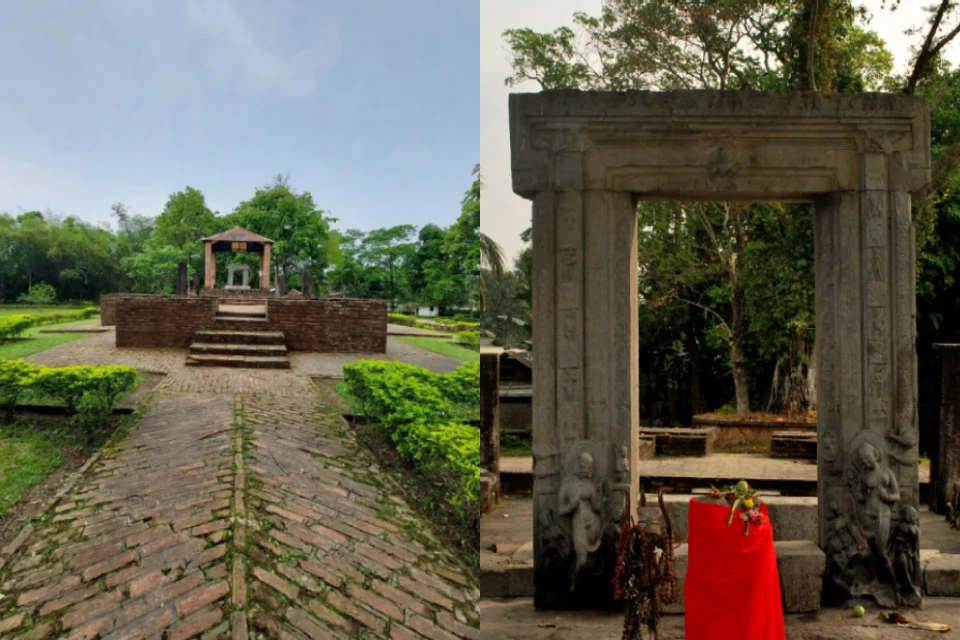Want to explore something spectacular in Assam? Explore the cultural essence of Da Parbatia temple and the story behind the stone gate of the sixth century.
Diversity Assam
Updated on :
Share this post
Da Parbatia is a hidden gem among the other scenic places of Tezpur. If you’re someone who loves to visit historical places trying to relive the moments of a past era then there’s nothing better than a quick trip to the town of Tezpur specially the village of Da Parbatia that is home to some ancient legacy and artistic wonder.

Image Credit: Bonsai Joy
Tezpur, the cultural capital of Assam. Situated on the North bank of river Brahmaputra, It is known as the land of eternal romance. The beautiful town of Tezpur holds importance in the state of Assam mainly because of it’s glorious past. From various archaeological sites to ancient remains, these ruins of the past embodies remarkable heritage, culture and art. From Agnigarh fort to Rudrapada temple, the ruins of Bamuni hills and architectural remains at Da Parbatia; the town of Tezpur displays a rich outline of heritage and culture.
The Village of Da Parbatia
Da Parbatia is a tiny village in Assam, towards the west of Tezpur in the district of Sonitpur. Significant architectural remains of a sixth-century temple is seen in this village, standing upon the ruins of an Ahom-era Shiva temple constructed of bricks. During 1924 archaeological digs, a large, intricately carved stone door frame from the sixth century was discovered. Built over the ancient temple’s foundations, the Ahom era temple ruins are arranged in the shape of a stone-paved garbhagriha and mandapa layout.
An artistic wonder
Over the remains of an old Gupta period temple, a Shiva temple was constructed using bricks during the Ahom period. The Gupta period temple’s remnants were only revealed as a stone door frame when the Ahom period temple was collapsed during the Assam Earthquake of 1897.
The most significant discovery here is the stone door frame, which is situated in front of a particular portion of a hollow stone that once held the original Shiva linga. The carvings on the door frame belong to the Gupta period art form. The Gupta period art traditions features human figures at the base of the door posts, representing the river goddesses Ganga and Yamuna which was seen on the carvings of the ancient ruins.
Additionally, flying geese carvings were also depicted. It is claimed that this architectural representation is the “finest and oldest specimen of sculptural art in Assam“.
The Temple History
With its carefully thought-out design that included a garbhagriha, a mandapa, and an ardha-mandapa, the temple of Da Parbatia proved to be a significant religious center at that time. The discovery of clay plates with human figures at the temple site, which are currently housed in the state museum, provides more evidence that the area surrounding the temple site must have been a site of great architectural work by the residents at some point before the Ahom period.
The temple is maintained by conducting daily rituals such as Archana and Aarti. Festivals like Kartik Purnima, Diwali and Maha Shivratri are celebrated every year here in a grand way. The nature of this remains indicates that Tezpur has been a religious center since a long time ago and it has quite significance upon the lives of people here. From prevailing practices of Shaivism to Shakti cult performed in the town, the history left a remarkable mark.
How to reach Da-Parbatiya
The beautiful village of Da Parbatia is just a few kilometers away from the main town of Tezpur. The nearest Airport is Tezpur Airport and then hiring a taxi or cab can take you to the village. But the most promising service would be the auto services that can directly take you to the temple.
If you want to make your visit fruitful then do visit the nearby places like Chitralekha Udyan, Mahabhairab Temple, Agnigarh Hill and Bamuni Hills.
Reference: https://www.academia.edu/74149722/Dah_Parbatiya_An_Archaeological_Study_of_the_Remains_of_the_Gupta_Period. Read here

